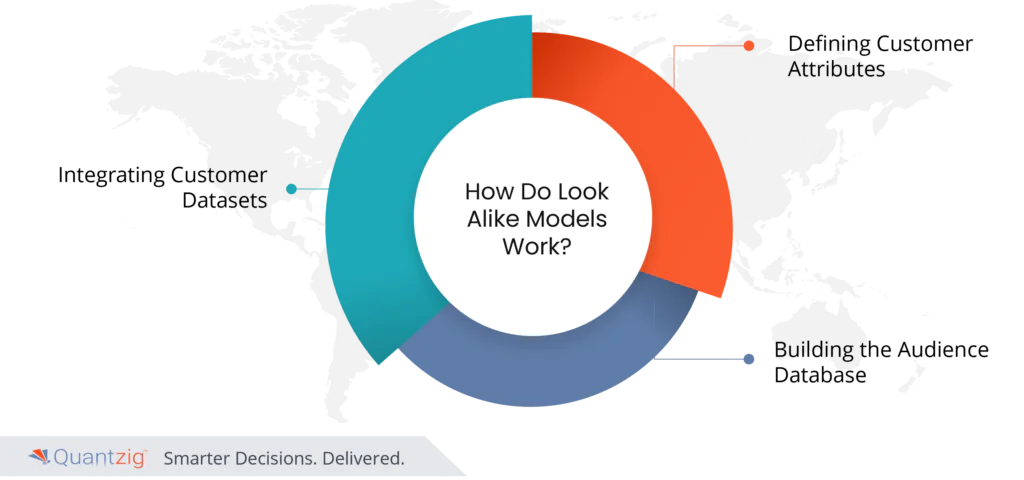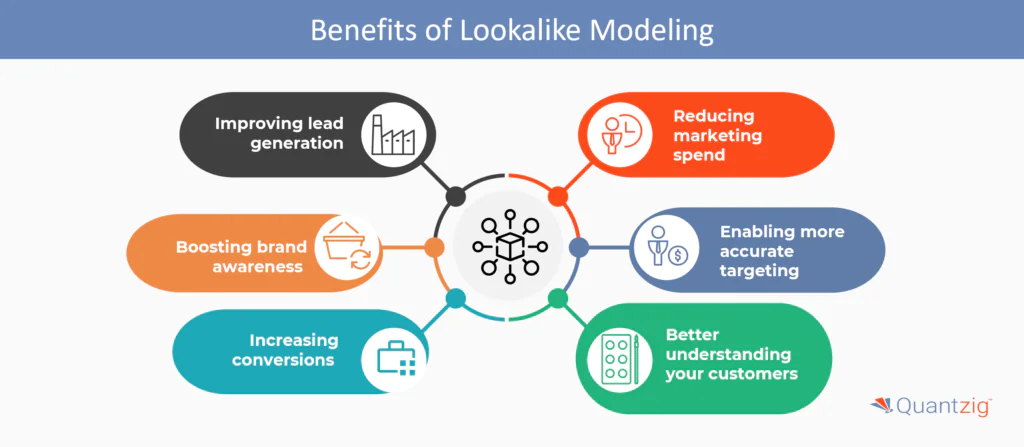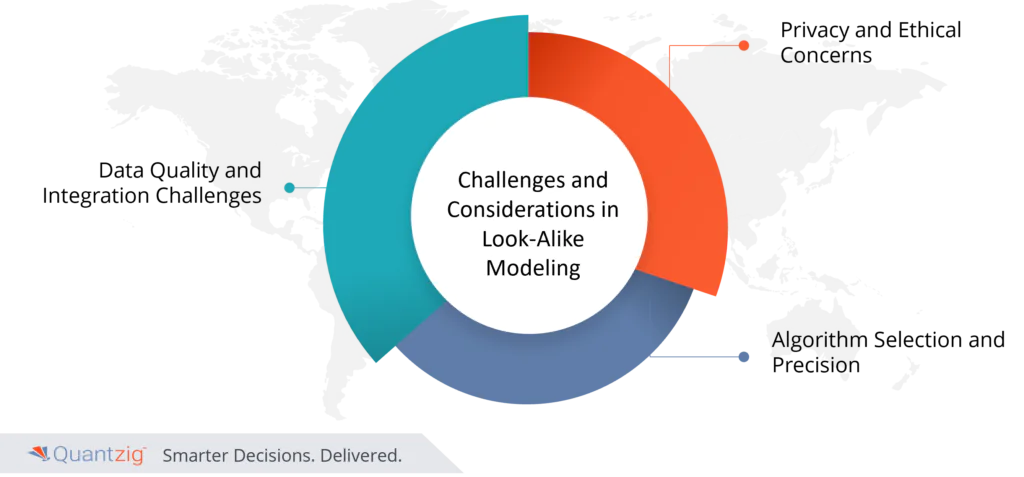Looking to supercharge your advertising campaigns? Look-alike modeling is a game-changer. This data-driven approach helps you target individuals who share traits with your top customers, unlocking a goldmine of potential clients.
Powered by machine learning, it analyzes demographic and behavioral data to pinpoint high-value prospects. Curious about how it works? Quantzig, an expert in advanced analytics, can guide you on seamlessly integrating it into your strategy. Let’s get started!
Book a demo to experience the meaningful insights we derive from data through our analytical tools and platform capabilities.
Request a DemoTable of Contents
What is Look Alike Modeling?

It is an advanced analytics methodology that can be leveraged to identify and acquire potential clients who behave like your existing clients. This approach relies on look-alike modeling algorithms and machine learning techniques to analyze customer behavior and buying patterns and leverages the insights obtained to find potential customers with similar attributes. In other words, it is the best approach you can adopt to ensure the effective use of your marketing dollars.
From a marketing perspective, our marketing analytics experts suggest that these techniques can be of great help to businesses trying to sell their products and services as it is very likely that look-alike identified through such techniques will turn into long-term customers. This means the perspective of growing your business and driving sales using accurate algorithms is quite impressive. Also, identifying and targeting look alikes can help businesses to optimize campaign budgets and improve marketing effectiveness by fine-tuning marketing strategies.
What Can Look-alike Modeling Be Used For?
Look-alike modeling is a powerful data-driven approach that helps businesses identify and target high-value customers by analyzing similarities between existing customers and potential prospects. This method enhances marketing efficiency by ensuring personalized outreach to the right audience segments.
| Use Case | Description |
|---|---|
| Customer Acquisition | Identifies potential customers who resemble high-value existing customers, improving conversion rates. |
| Personalized Marketing | Enables tailored campaigns by segmenting audiences based on behavioral and demographic similarities. |
| Ad Targeting Optimization | Enhances ad performance by refining audience selection, reducing acquisition costs, and increasing engagement. |
| Churn Prediction & Retention | Helps businesses predict customer churn and develop targeted retention strategies to enhance loyalty. |
| Market Expansion | Assists in exploring new geographies and demographics by finding similar audiences in untapped markets. |
By leveraging look-alike modeling, businesses can optimize marketing efforts, enhance customer engagement, and drive higher ROI. It enables precise audience targeting, reducing costs and improving overall campaign effectiveness.
How Do Look Alike Models Work?
It is a powerful analytical technique used in lead generation to optimize marketing spend. By analyzing a seed audience through predictive modeling, businesses can identify similar prospects. This technique is essential for effective retargeting campaigns and refining marketing strategy. Particularly beneficial for an ecommerce store, it leverages data collection from data-management platforms (DMP) and demand-side platforms (DSPs) to enhance targeting precision.
Though it sounds like a herculean task, it is pretty simple as afar as you have the datasets and analytics capabilities to analyze your data.

Step 1: Integrating Customer Datasets
Data can be obtained from several internal and external databases, including CRM tools, customer touchpoints, websites, and other external sources. To make the most out of it, businesses must integrate data sets on a common platform and deploy data models to extract insights. These models do just that but from a perspective of identifying new customers to maximize the effectiveness of your marketing campaigns. Since data is the starting point, irrespective of the look-alike modeling techniques used, the more information you have, the more likely you are to build a better lookalike audience portfolio.
Step 2: Defining Customer Attributes
Once you’ve identified and integrated data from all relevant sources, you’ll have to leverage advanced look alike modeling techniques to analyze those data sets and identify potential customers. This might vary from person-to-person depending on the data sources being used. However, specific seed audiences can be created by combining customer attributes obtained from different data sets. The more precise your look-alike model, the easier it is to find your potential customers.
Step 3: Building the Audience Database
The final task of building a look alike customer base is generally done in the demand-side platform (DSP) or the data management platform (DMP) and may vary depending on the platform being used. However, if your only focus is to drive brand awareness then being less strict with your attributes will help you generate a larger audience database that will most likely drive brand reach.
Eventually, the look alike modeling being used depends on the goals of your marketing campaigns and what you want to achieve by building a look alike customer database. But if your marketing initiatives are built around targeting specific people with a high-value proposition, then it’s crucial to use narrowly defined behavioral traits to maximize reach and marketing outcomes.
Role of Look Alike Modeling in Marketing
Audience Expansion:
Look-alike modeling helps marketers find new prospects who share behavioral and demographic traits with their existing customers, known as the seed audience. This allows businesses to reach broader yet relevant audiences.
Improved Targeting:
By analyzing the attributes of high-value customers, marketers can create precise audience segments. These segments exhibit higher engagement and conversion rates compared to broader classifications based on general demographics like age or location.
Enhanced Advertising ROI:
Targeting look-alike audiences reduces wasted advertising spend by focusing on users who are more likely to engage with campaigns. This leads to higher conversion rates and better return on investment.
Lead Generation:
Look-alike modeling identifies high-quality leads beyond the existing customer base, ensuring that marketing efforts are directed toward prospects with a higher likelihood of becoming loyal customers.
Data-Driven Insights:
Using platforms like Customer Data Platforms (CDPs) or Data Management Platforms (DMPs), marketers can integrate online and offline data sources to refine look-alike models and continuously improve targeting strategies.
Scalability:
Look-alike modeling allows businesses to scale their campaigns effectively by building larger audiences that mirror the characteristics of smaller, profitable customer groups.
How Can Marketers Benefit from Look Alike Modeling Marketing?

| Key Benefits of Look-alike Modeling | How It Works | Why Choose Quantzig? |
|---|---|---|
| 1. Improved Lead Generation | Look-alike modeling leverages machine learning to identify high-quality prospects who mirror your best customers’ behaviors, leading to higher lead quality. | Quantzig specializes in pinpointing these high-value leads, ensuring your marketing efforts are laser-focused and effective. |
| 2. Reduced Marketing Spend | By narrowing your target audience to high-value lookalike audiences, you enhance ROI and lower acquisition costs. This approach targets those most likely to convert, optimizing your spend. | Quantzig’s data-driven strategies help you maximize your budget by focusing on audiences that deliver the highest returns. |
| 3. Enhanced Brand Awareness | Gain access to new, relevant audiences that match your ideal customer profile, increasing brand exposure and engagement. | Quantzig ensures your brand reaches the right eyes, boosting awareness and driving interest among potential customers. |
| 4. More Accurate Targeting | By analyzing and comparing data from your current customers with broader web audiences, look-alike modeling fine-tunes your targeting precision. | With Quantzig’s expertise, your campaigns are tailored for accuracy, delivering personalized experiences that resonate with your audience. |
| 5. Increased Conversions | Higher quality leads lead to higher click-through rates (CTR) and conversions, driving revenue and business growth. | Quantzig helps you turn high-quality leads into loyal customers, fueling your company’s expansion with data-backed strategies. |
| 6. Deeper Customer Insights | Look-alike modeling provides valuable insights into customer behaviors and preferences, essential for refining your marketing strategies. | Quantzig unlocks actionable insights, helping you understand what drives your customers and how to keep them engaged. |
Experience the advantages firsthand by testing a customized complimentary pilot designed to address your specific requirements. Pilot studies are non-committal in nature.
Request a pilot
Challenges and Considerations While Implementing a Look-alike Model:

Look-alike modeling faces challenges such as accurate data collection and defining a precise seed audience. Implementing this analytical technique requires robust predictive modeling and integration with data-management platforms (DMP) and demand-side platforms (DSPs). Ensuring data quality affects lead generation and the effectiveness of retargeting campaigns.
Additionally, balancing marketing spend and aligning the marketing strategy with ecommerce store objectives can be complex and resource intensive. Some of the challenges include:
1. Data Quality and Integration Challenges:
Ensuring the quality and integration of diverse datasets can be challenging. Robust data governance practices and collaboration between departments are crucial to overcoming these challenges.
2. Privacy and Ethical Concerns:
The use of customer data in look-alike modeling raises privacy and ethical considerations. Stringent privacy policies, anonymization of data, and compliance with regulations are essential to address these concerns.
3. Algorithm Selection and Precision:
Choosing the right algorithms is critical. The level of precision in defining customer attributes directly impacts the accuracy of the model and its effectiveness in targeting the desired audience.
Get started with your complimentary trial today and delve into our platform without any obligations. Explore our wide range of customized, consumption driven analytical solutions services built across the analytical maturity levels.
Start your trialHow to Build a Look-alike Model?
A look-alike model helps businesses identify potential customers who share characteristics with their existing high-value customers. By leveraging advanced analytics, organizations can improve targeting and enhance marketing efficiency.
| Steps | Description |
|---|---|
| Define Seed Audience | Identify a group of existing customers with desired traits. |
| Gather Data | Collect demographic, behavioral, and transactional data. |
| Feature Engineering | Select and preprocess key variables that influence customer similarity. |
| Train the Model | Use machine learning algorithms to identify patterns in the seed audience. |
| Validate and Deploy | Test the model’s accuracy and apply it to discover new lookalike customers. |
A well-built lookalike model refines audience segmentation, enhances personalization, and improves marketing ROI by targeting prospects most likely to convert.
Conclusion:
Look-alike modeling has become an indispensable tool in the marketer’s arsenal, offering a data-driven approach to enhance targeting precision and campaign effectiveness. By understanding the steps involved in this solution, businesses can leverage model look alike techniques and explore its applications in marketing to unlock new avenues for growth, customer acquisition, and brand awareness. While challenges exist, strategic implementation and a commitment to data quality and privacy considerations can ensure the successful integration of model look alikes into comprehensive marketing strategies. As the marketing landscape continues to evolve, embracing innovative approaches like look-alike modeling will be pivotal for sales teams, business owners, and marketers to achieve success.




